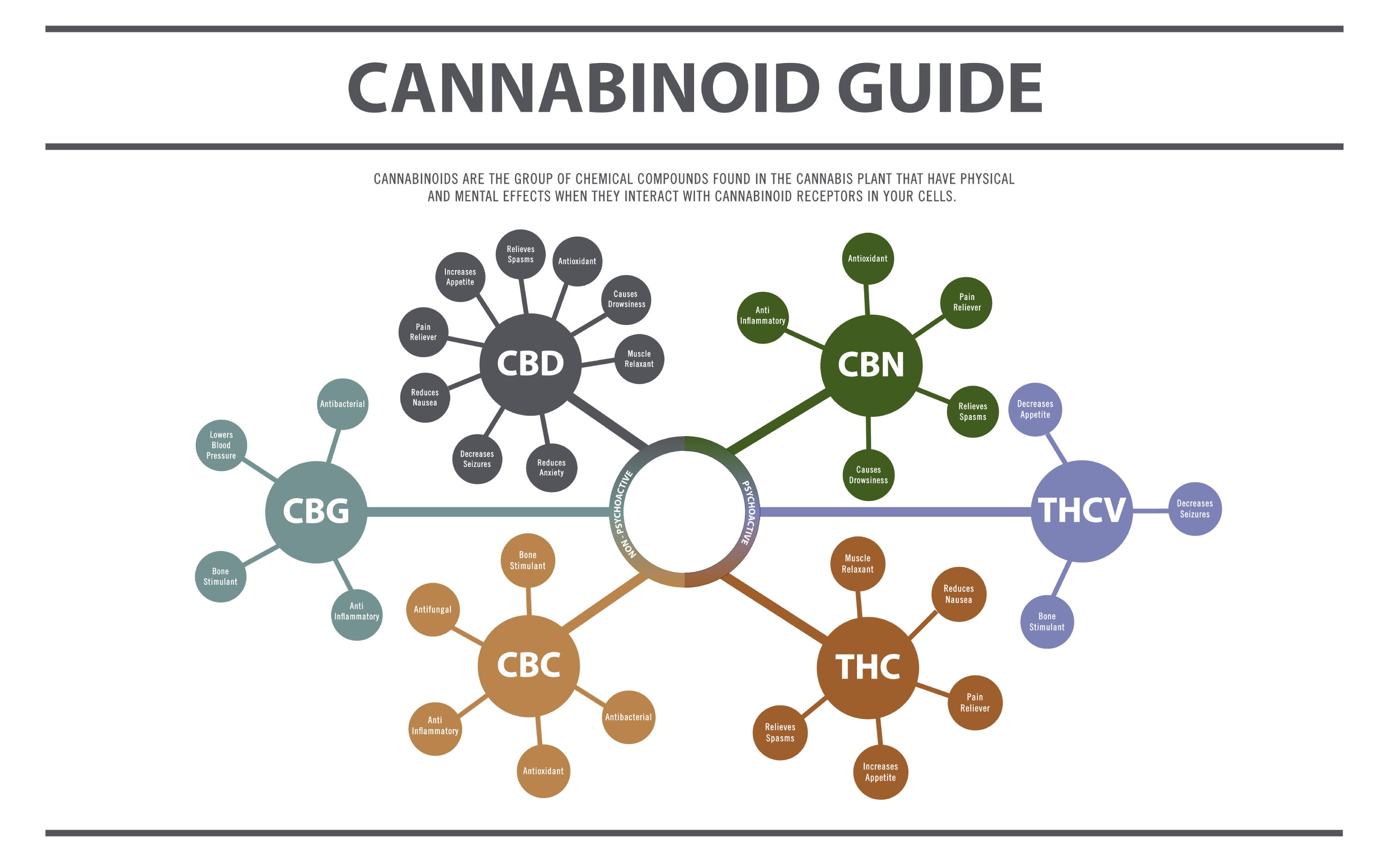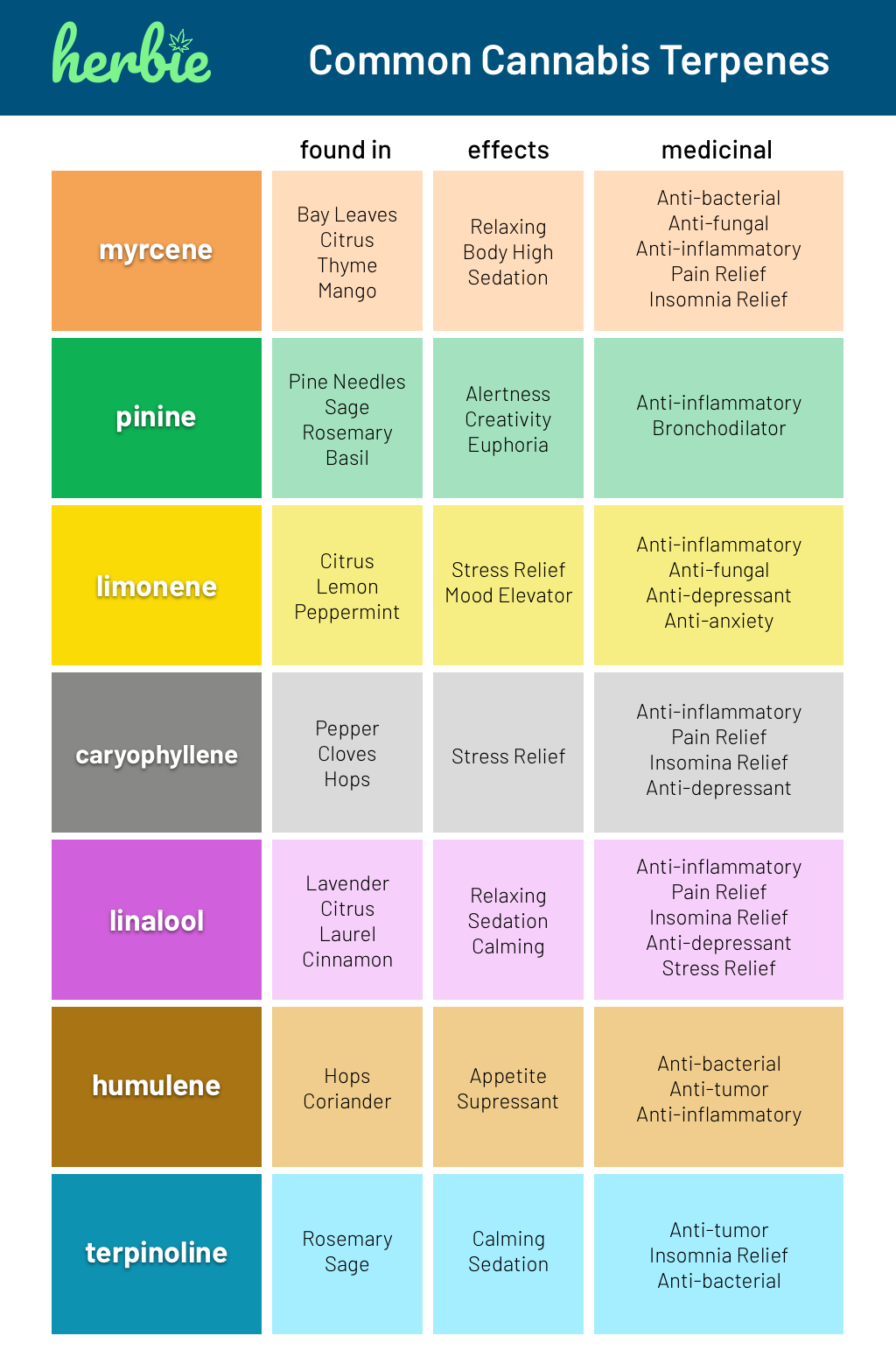Cannabinoids and Terpenes Explained
These statements have not been evaluated by the Food and Drug Administration.
These products are not intended to diagnose, cure, mitigate, treat, or prevent any disease.
Cannabinoids
There are approximately 65 cannabinoids in the cannabis plant. These break down into two main groups, THC (containing THCA, THC, THCV, etc), CBD (containing CBDA, CBD) and CBG, CBN and more. THC is usually thought of as the cannabinoid that gets you high and CBD as the healing one. This is not exactly true. THC also has significant healing benefits with regard to pain relief, digestion and mood. CBD may help in reducing stress and inflammation, helping with sleep, improving appetite as well as acting as a counterbalance to the psychoactive effects of THC. Each of these cannabinoids may have their own individual benefits, but may also work well in combination.
This guide shows the main groups of cannabinoids and some of their properties.

Discovered only about 30 years ago, each of us, along with most animals, have an endocannabinoid system (ECS). This is a system of receptors which are distributed throughout our bodies that works to modulate a number of important functions. Some of these functions impacted by our ECS are:
- Nervous System
- Stress and Mood
- Cardiovascular Health
- Appetite and Digestion
- Immunity and Inflammation
- Fertility and Reproduction
So, pretty important, yeah?
While our bodies are able to create "endo" (internal) cannabinoids on demand, these may only be short lived. Supplementing with additional "phyto" (plant-based) cannabinoids can provide longer lasting effects to our ECS as well.
Let's take a moment to examine a strain to see what sort of cannabinoids were found. This strain is called Ultra Kush and contains a relatively high amount of CBD (CBDA 16.993% + CBD 0.898% = 17.89%) and very low amounts of THC (D9-THC 0.099%). That said, our Ultra Kush also contains small amounts of CBGA, CBC, CBDV and THCA. These trace cannabinoids may also impart a small effect as well.

Leafly, one of the best sites for cannabis information, felt that cannabinoids and terpenes are so important to the effects and experience of cannabis and hemp, that they created an entirely new way of looking at each strain's information. But cannabinoids aren't the only important chemicals in cannabis, we can't forget about the terpenes! Let's see how terpenes add to the cannabinoids to complete the entourage effect.
Terpenes
If you've ever smelled the slightly spicy aroma of a freshly grown tomato or the sweet/sour scent of citrus or the heady scent of lavender, you have experienced terpenes. Terpenes are aromatic oils that give cannabis and other plants their unique aroma and flavor profile. Plants produce them in the wild to ward off predators and attract pollinating insects. Humans have been using terpenes (as a component of essential oils) for thousands of years for their healing properties.
It is believed that terpenes are produced within the trichomes of the plant (the "frost" that is visible on high quality herb) which are very fragile. Mishandling your herb through poor storage methods will degrade the quality of your product, so respect your terps!
In cannabis, there are about 140 terpenes, with some of the most common being Myrcene, Limonene, Pinene and Caryophyllene. Each strain of cannabis will have some combination and proportion of terpenes that will lend to its flavor, aroma and its effects.
While some growers are focused only on high-THC producing plants (at the expense of terpenes), others are focusing on increasing the terpene profile to create the richest combinations. If you are interested in using cannabis for treating particular conditions, you should pay attention to the terpenes in your product. It is these terpenes in cooperation with the cannabinoids that create the "entourage effect" that you experience when you partake.
Here are some common cannabis terpenes and their effects.....
 Myrcene
Myrcene
The most common terpene (dominant in 40% of strains) and one usually present in significant amounts in many strains is myrcene. Myrcene has a spicy, peppery aroma and is found in hops, mango and lemongrass. Myrcene has a very relaxing effect and provides a strong "body high" feeling, the "couch lock" that people often attribute to Indica strains of cannabis. Myrcene also helps to lower resistance across the blood-brain barrier, so the effect of the cannabinoids and terpenes may be felt faster with higher levels of myrcene. It is also anti-inflammatory, excellent for pain relief, has anti-fungal and anti-bacterial properties as well as being anti-mutagenic (preventing DNA damage from some toxins).
Caryophyllene
The next most common terpene (dominant in 30% of strains) is caryophyllene. Caryophyllene has a spicy, warm aroma found in cloves, cinnamon and black pepper. Caryophyllene is a unique terpene in that it behaves like a cannabinoid and directly activates the endocannabinoid system receptors. Its main effects are pain relief, anti-inflammation, relaxation and the reduction of anxiety and stress.
Limonene
Pinine
Linalool
Humulene
Some Final Thoughts
